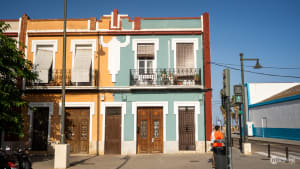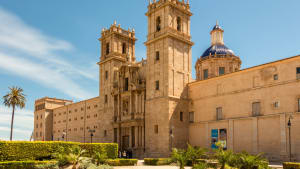
Fallas Quick Guide for Beginners
Explosive, colorful, and loud, Fallas is Valencia's most spectacular festival! If you've never experienced this extraordinary celebration before, this guide will help you understand the essentials of this UNESCO-recognized tradition.
Fallas Quick Guide for Beginners in a nutshell...
Valencia’s Fallas festival transforms the city each March with nearly 800 spectacular sculptures, daily fireworks, and culminates in ceremonial bonfires on March 19th that symbolize renewal.
The festival centers on three key elements: satirical fallas sculptures (depicting current events with extraordinary craftsmanship), choreographed pyrotechnics (from thunderous daytime mascletàs to nighttime displays), and traditional activities organized by local neighborhood committees whose members parade in elaborate costumes.
It’s better to prepare for the intense March 15-19 period by booking accommodation months in advance, bringing earplugs for constant fireworks, dressing comfortably for walking and smoke, and embracing the city’s late-night schedule while experiencing essential events like the mascletàs (daily at 2pm), flower offering, and La Cremà burning ceremony.
Welcome to the world of Fallas, Valencia’s most iconic festival and one of Spain’s most extraordinary celebrations. Each March, this Mediterranean city transforms into an open-air museum of art, a symphony of explosions, and ultimately, a massive ceremonial bonfire, creating an experience that engages all your senses and stays with you long after the flames die down.
For first-time visitors, Fallas can be wonderfully overwhelming. The city fills with nearly 800 stunning sculptures, daily firework displays shake the ground beneath your feet, music echoes through streets crowded with people in elaborate traditional costumes, and the scent of gunpowder mingles with the aroma of street food being prepared on every corner.
To help with the overload and make things easier, this quick guide will walk you through the essentials of Fallas: what it is, when it happens, what you’ll see, and how to make the most of your experience.
What’s Fallas?
Fallas, or Falles in Valencian, is a traditional Valencian celebration held every year in the first three weeks of March. The festival, which is a recognised as UNESCO Intangible Cultural Heritage , is highly anticipated by the city at large.
Fallas is essentially a non-religious celebration, and stories about its origins are contrasting. According to some, it is a descendant of pagan spring festivities. According to others, Falles was born as a way for carpenters to celebrate their patron, Saint Joseph. To others yet, it is both.
Whatever the origins, the festival is today one of the most famous folkloristic events in Spain. Millions of visitors come to Valencia to participate every year, especially on the occasion of the Semana Fallera (14th-19th March), the final and most spectacular days of the festival.
Falles is a delightful cacophony of bright colours, satirical sculptures, loud fireworks, parades, and bonfires. All accompanied by much music, flowers, and an incredibly joyful and euphoric atmosphere of camaraderie and trepidation.

Now, because there might be some confusion: the word fallas can actually indicate a few different things. It is the Fallas festival, for sure. But it is also the word used to refer to the huge sculptural compositions built on the occasion of the event.
These fallas, made up of different figures called ninots, are built in papier-mâché, wood, and styrofoam. They represent allegorical or fantastical scenes, often with the intent to reference or satirise current socio-political events.
Almost 800 of these scenes are placed all around the city during Fallas, and at the end of the festival, they are all burned in massive, spectacular bonfires. But something else Falles is known for is the fireworks. Valencians love to put on deafening, bombastic pyrotechnic displays that shake the ground and echo in the streets during the entire duration of the festival.
The Three Essential Elements
Fallas revolves around three fundamental components that define this unique celebration. Understanding these elements will help you appreciate the depth and significance of everything you’ll experience during your visit.
1. The Fallas Sculptures
These massive papier-mâché and wooden sculptures appear throughout the city, often depicting satirical scenes about current events. The creativity and craftsmanship are extraordinary!
Each falla tells a story. Sometimes political, sometimes cultural, always with a touch of Valencian humor. These incredible monuments can reach several stories high and feature dozens of detailed figures called “ninots.” Walking among them feels like exploring an open-air art gallery where traditional craftsmanship meets contemporary commentary.
The sculptures are divided into various categories and compete for prestigious prizes. As you explore the city, you’ll notice differences in size, style, and artistic approach, from the grand, elaborate fallas in the city center to the charming, community-focused creations in residential neighborhoods.
2. Fire
The festival concludes with “La Cremà”, the dramatic burning of all sculptures on the night of March 19th. This symbolic act represents renewal and rebirth as winter turns to spring.
Fire is the transformative element of Fallas. After days of admiring these artistic masterpieces, witnessing them being consumed by flames creates a powerful emotional experience.

For Valencians, this represents letting go of the old and making space for new beginnings. The burning begins with children’s fallas in the early evening and continues until the final, massive municipal falla burns around midnight.
3. Fireworks
From start to finish, Valencia erupts with pyrotechnic displays, from the thunderous daytime “mascletàs” to breathtaking nighttime firework shows that light up the sky.
Pyrotechnics aren’t just part of the celebration, they are a defining characteristic of Fallas. The daily mascletà in Plaza del Ayuntamiento draws thousands who gather to feel the rhythmic explosions that are so powerful they seem to shake the entire city. These aren’t typical fireworks but carefully choreographed compositions of sound and sensation.
Nighttime brings different displays, with stunning “castillos” (firework castles) illuminating the sky in brilliant colors. The crescendo comes on March 18th with “La Nit del Foc” (Night of Fire), when the sky above the Turia riverbed becomes a canvas for the most spectacular pyrotechnic show of the year. Even for those who have seen fireworks around the world, the Valencian approach to pyrotechnics during Fallas is on another level entirely.
When Does It Happen?
While preparation takes a full year, the main festivities run from late February through March 19th (Saint Joseph’s Day). The most intense celebrations occur during the final days (March 15-19).
Fallas isn’t just an event, it’s a season. The festival officially begins with “La Crida” (The Call) in late February, when the Fallera Mayor announces the start of festivities from the Torres de Serranos. From March 1st, daily mascletàs begin punctuating afternoons at 2:00 PM sharp, gradually building excitement throughout the city.

The rhythm of life in Valencia changes completely during this period. Streets become pedestrian zones as sculptures take over public spaces, music plays continuously, and the smell of gunpowder and traditional street food fills the air. As a first-time visitor, you’ll notice the energy building day by day, reaching its peak during the final five days when the city barely sleeps.
Key dates
Late February: Official opening ceremony (“La Crida”)
March 1-19: Daily mascletàs at 2:00 PM
March 15-16: “La Plantà” (installation of sculptures)
March 17-18: Flower offering to the Virgin
March 19: The grand finale with “La Cremà”
The closing days create a whirlwind of emotion and activity. After “La Plantà” (when all sculptures must be completed and installed), judges evaluate them for prizes while visitors marvel at their artistry.
The flower offering creates rivers of color through the streets, leading to a massive floral tribute to the Virgin. Finally, the burning night arrives, marking the bittersweet end to weeks of celebration.
See more: Detailed Fallas calendar →
Must-See Events
Every day during Fallas offers something special, but these events shouldn’t be missed if it’s your first time experiencing the festival:
Mascletàs: Experience these daytime pyrotechnic concerts in Plaza del Ayuntamiento daily at 2:00 PM
La Plantà: Watch as hundreds of sculptures appear overnight across the city on March 15-16
Flower Offering: Witness thousands of falleros in traditional dress creating a beautiful flower mantle for the Virgin (March 17-18)
Nit del Foc: The “Night of Fire” features the most spectacular fireworks display on March 18
La Cremà: The emotional burning of all sculptures on the night of March 19
See more: Unmissable Fallas events →
Who Makes It Happen?
Fallas is organized by local neighborhood committees ("comisiones falleras") whose members ("falleros" and “falleras”) fundraise year-round. During the festival, they parade in traditional costumes and each committee selects representatives including a “Fallera Mayor” (queen of the festival).
There are also the artists ("artistas falleros") who design and construct the monumental sculptures. These skilled craftspeople work year-round in specialized workshops, combining traditional techniques with modern innovations to create the stunning fallas that define the festival.
Many come from families with generations of fallas artists, passing down closely guarded techniques and artistic vision.

Another important entity is the Junta Central Fallera, which oversees the entire festival. This governing body coordinates between committees, establishes rules for competitions, selects the Fallera Mayor of Valencia, and ensures that centuries of tradition are maintained while allowing the festival to evolve. Throughout the year, they work closely with city officials to plan the complex logistics required for this massive celebration.
See more: The people behind Fallas →
Good to Know
Before diving into your first Fallas experience, here are some practical tips to help you make the most of this extraordinary festival:
It’s LOUD! - Fireworks and firecrackers are everywhere, all day and night. The constant explosions can be startling even for those who know what to expect. Bring earplugs, especially for the mascletàs, where sound pressure can reach physically uncomfortable levels. Consider noise-canceling headphones for young children or anyone sensitive to loud noises.
It’s safe, but stay aware - Despite the seemingly chaotic nature of the fireworks, Fallas has strict safety protocols. Designated areas for pyrotechnics are cordoned off, and the firefighters (bomberos) are always present during major events. Still, remain vigilant, follow crowd instructions, and maintain a reasonable distance from burning monuments during La Cremà.

Pets don’t like it - The constant noise and crowds make Fallas extremely stressful for animals. If possible, arrange for pets to stay outside the city during the festival. If you must bring a pet, consider noise protection, stay far from pyrotechnic events, and have a quiet retreat space available.
Plan ahead - Accommodations fill quickly and prices surge during Fallas. Book months in advance if possible. Many streets are closed to traffic, particularly in the city center, so research transportation options and be prepared for longer travel times. The Valencia Tourist Card offers unlimited public transport and is worth considering.
Dress comfortably - You’ll be walking a lot and might encounter smoke or ash. Wear layers (March evenings can be cool), comfortable shoes, and nothing you can’t bear to have slightly singed by a stray ember. Bring a scarf that can cover your mouth and nose during particularly smoky events.
Night owl friendly - Many events happen late at night, with some beginning after midnight. The Cremà of the main municipal falla doesn’t usually start until after 1:00 AM, and the city remains lively until dawn. Adjust your sleep schedule accordingly, or plan for afternoon siestas to recover.
Hydrate and eat strategically - Street food stalls are abundant, but restaurants may have long waits or special hours. Carry water, especially during daytime events. Traditional Fallas treats like buñuelos (pumpkin fritters) and chocolate con churros provide the energy needed for long festival days.
See more: Tips for your Fallas experience →
Fallas Vocabulary
Here are a few essential terms to help you understand the festival:
Falla: Both the festival and the sculptures themselves
Ninot: Individual figures that make up a falla sculpture
Mascletà: Rhythmic, thunderous daytime firework display
Cremà: The burning of the sculptures on the final night
Fallero/Fallera: Festival participants in traditional dress
Learning a few key Fallas terms will enhance your experience and help you connect with locals during the festival. The language of Fallas is a blend of Valencian (a variant of Catalan) and Spanish, reflecting the region’s bilingual heritage.
You’ll hear these words constantly during your visit, as they describe unique elements that don’t have direct translations.
See more: Complete Fallas vocabulary guide →
Curious Facts
The fascinating history and unique traditions of Fallas are filled with interesting details that enhance your appreciation of this remarkable celebration:
- Fallas earned UNESCO Intangible Cultural Heritage status in 2016, recognizing not just the festival itself but the entire cultural ecosystem that sustains it, from artisanship to music to community organization
- The tradition may have begun with carpenters burning wooden lamp stands to celebrate St. Joseph, their patron saint, after winter when longer daylight hours made them unnecessary
- Each year, one “ninot” from each category is pardoned from burning and preserved in the Fallas Museum, creating a unique historical record of artistic styles and social commentary
- The largest fallas monuments can cost over €200,000 to create and require teams of artists working year-round
- The traditional fallera costume can weigh over 60 pounds (27 kg) and includes handmade silk dresses, antique jewelry, and elaborately styled hair that can take hours to arrange
See more: Fascinating Fallas curiosities →
Types of Fireworks
The festival features various pyrotechnic elements, from small firecrackers to massive displays:
Mascletà: The iconic daytime pyrotechnic event focused on creating rhythmic compositions of sound rather than visual displays. These carefully choreographed explosions build in intensity, creating sound waves you can feel through your entire body. The daily mascletà in Plaza del Ayuntamiento is the most famous, but neighborhood committees host their own versions throughout the city.

Castillos de Fuegos: These “firework castles” are elaborate nighttime displays launched from metal structures. Unlike the sound-focused mascletàs, castillos emphasize visual beauty with a variety of colorful effects. The most spectacular castillo occurs during Nit del Foc (Night of Fire) on March 18th, featuring thousands of aerial fireworks over the Turia Gardens.
Traca: A string of firecrackers connected by a fuse that creates a running line of sequential explosions. Tracas are often hung vertically along buildings or wound around fallas sculptures during the Cremà to accelerate the burning process. The “Traca Final” marks the official end of Fallas when the last monument has been consumed by flames.
Tro de Bac: A powerful impact firecracker that doesn’t require a fuse. It explodes when thrown forcefully against the ground. These are primarily used during the morning “despertà” parades. Due to their intensity, handling tro de bac requires a special license, and they’re only used by authorized falleros.
Bombetas: Smaller firecrackers used primarily by children during Fallas. These tiny explosives create a pop when thrown against the ground but are less powerful than tro de bac. They’re often seen during children’s events and family-friendly activities throughout the festival.
Cordà: A spectacular night event where pyrotechnicians inside a metal cage simultaneously light hundreds of whistling rockets that crisscross above spectators’ heads. The result is a chaotic but controlled aerial display that fills the night with light, sound, and smoke.
See more: All about Fallas fireworks and pyrotechnics →
Planning Your First Fallas Visit
Experiencing Fallas for the first time requires some strategic planning to make the most of this intense festival. The city center offers the most convenient access to major events, though accommodation prices are higher and noise levels constant. Areas like Ruzafa, El Carmen, and Benimaclet put you close to the action while offering slightly more breathing room.
Creating a flexible itinerary allows you to balance the major events with spontaneous discoveries. Plan to experience at least one mascletà in Plaza del Ayuntamiento, spend an evening exploring the award-winning fallas sculptures, witness part of the flower offering, and stay for one of the nighttime fireworks displays. The Cremà on the final night is the emotional culmination of the festival, with different sculptures burning throughout the evening.
Remember that Valencia becomes a different city during Fallas. Many businesses operate on special schedules, public transportation runs modified routes, and the normal rhythm of daily life transforms completely. Embracing this temporary chaos is part of the authentic Fallas experience!
And most of all, pace yourself during the festival. Fallas is a marathon, not a sprint!
See more: Guide to visit Valencia during Fallas →



















